Salvatore Albert Lombino, aka Evan Hunter, inspired by Jack Webb, wrote around fifty 87th Precinct police procedural novels under the pen name Ed McBain. The 87th Precinct novels were the preeminent police procedural novels for close to half a century. Akira Kurosawa was a fan. A combination of fandom and growing concern about how lightly kidnapping was treated as a crime in Japan inspired Kurosawa to adapt McBain’s 1959 novel King’s Ransom into High and Low, which is otherwise known as Heaven and Hell.The result is a full-fledged masterpiece.
The film opens in the opulent home, which overlooks much of Yokohama, of National Shoes executive Kingo Gondo (Toshiro Mifune), a Japanese wink at the title character of McBain’s novel whose last name is King. Gondo starts out in twilight darkness and turns on a light as he is being pitched a deal to take over their shoe company from the out of date “old man” owner. The three rival executives want to go with a stylish but cheap shoe that will wear out quickly. Gondo sits in judgment, Kurosawa deliberately frames him from a low angle, as he listens to the pitch.
It’s not long until it’s revealed that Gondo has no time for the trio of executives because he actually wants to have pride in the shoes he manufactures. It’s apparent that he’d been hearing them out as a courtesy, and perhaps in the hope that they’d choose Gondo to head up the company. When he refuses, they realize that he’s their enemy as well.
Again you can see Kurosawa’s very careful compositions in action. At this point, Gondo is surrounded by his enemies who are trying to impose their position on him. What makes it work is not that it’s subtle, but that Kurosawa makes it all seem natural with his careful camera movements and editing. He’s not necessarily doing anything flashy with the camera, but using careful staging to create these images.
Following the pitch, we meet Gondo’s wife Reiko (Kyoko Kagawa), and Gondo’s assistant, Kawanishi (Tatsuya Mihashi). As Kawanishi shows the rival executives out, Gondo is interrupted by his son and the chauffer’s son playing cowboys and outlaws. The two young boys switch roles, with Gondo’s son switching from sheriff to outlaw. Kurosawa, careful as always, casts the role so that the boys do look alike. Gondo, in a nice bit of foreshadowing of his own plans, advises his son to lay an ambush instead of waiting to be hunted down. An idea that Reiko finds distasteful, but which demonstrates Gondo’s understanding of how the world works. It also demonstrates that Reiko is old fashioned and perhaps naïve about the world, further underscored as she wears a traditional kimono. We don’t exactly like Gondo, but we admire that he’s capable, competent, and a realist. His western style clothing sells us that he’s a modern business man.
And, in a continuing motif, people are wearing white clothing in the house, underlining the fact that Gondo’s place is the proverbial heaven of the alternate title.

The boys go out to play and Gondo receives the first of many phone calls in the film. It’s at this point, after some minor buildup, that he reveals his plan. He’s been quietly buying up shares and taking out loans to leverage control of the company for himself. Now he’s in position to buy the last set of shares that he needs to take control of the company, at enormous expense, at the next shareholders meeting. He’s borrowed against everything, and he’ll still need to come up with more money, but he’s finally in control. Kawanishi to get on the next flight to Osaka to deliver a check for 50 million Yen as a deposit on the loan.
Gondo appears to be at a point of triumph. But the next call he gets knocks him from his perch. Someone calls and announces that he’s kidnapped Gondo’s son. And demands 30 million Yen as payment and that Gondo doesn’t call the cops. Gondo’s instantly crushed and gives in.

Kurosawa chooses to keep the focus on Gondo and his home. A typical kidnapping movie would cut to a sequence where we see the kidnapping occur. Instead, the camera never leaves Gondo’s house at any point in the opening. A place where he can overlook the whole city below him quickly becomes a claustrophobic prison. Kurosawa will go more literally into Heaven and Hell territory later, but Gondo’s home becomes both at this point.
Then the first major twist occurs, Gondo’s son walks in. It turns out the kidnappers grabbed the chauffer’s son instead of Gondo’s son.
At this point, Gondo calls the police for help. It would be absurd for him to pay the ransom for someone else’s son and bringing the police in is the right choice. It’s also clear, right from the start, that the police are a competent bunch. They show up disguised as delivery men and realizing that the place is probably under surveillance have the drapes closed right away. The saying goes that the easiest way to make the audience like a character in a movie is to make them good at their job, and these guys are clearly good at their job.
They immediately get to work on setting up a recording device on the phone and we’re introduced to two significant characters. First is Tatsuya Nakadai as Chief Detective Tokura who gets to play a good guy for a change after being the main antagonist in Yojimbo and Sanjuro. He’s clearly a professional and let’s Gondo know right away that their first priority is getting the kidnapped boy back safely. The other is Chief Detective ‘Bos’n’ Taguchi (Kenjiro Ishiyama) who, with his bald head and heavy frame, is clearly the more down to earth, tough guy cop. Taguchi also gets to rub his head in the manner of Takashi Shimura in Seven Samurai, a gesture that never gets old in a Kurosawa film.
At this point, Kurosawa is content to put out a master class in how to raise tension and turn the screws on Gondo. Along with that, Kurosawa is also playful within the parameters of a thriller. For starters, Kurosawa is creative in how the standard tropes are played out. Why listen to a conversation between Gondo and the kidnapper, something that we’ve already seen, when we can just cut from Gondo picking up the phone to the police replaying the conversation and get everyone’s reaction?

And, Kurosawa pays great attention to using the whole wide frame and how people are positioned. It turns out that the kidnapper still wants Gondo to pay the full ransom, as absurd as it may seem. And Gondo struggles with it. There’s literally no escape for him as he’s cornered in his own house with a great moral dilemma. What’s more important, his family’s prosperity or the life of an unrelated child?
Kurosawa shows the dilemma plainly, alternating between shots of Gondo and the kidnapped boy’s father and Gondo and his family. And how isolated Gondo is when he states that he won’t pay. Sometimes he’s literally backed into a corner. And the blank walls hold no answers.

The result is a no win situation for Gondo. He puts off sending Kawanishi to make the loan deposit, which results in Kawanishi betraying Gondo to the rest of the board of directors to save his own hide. He endures the taunts of the kidnapper, who clearly is watching Gondo’s home, which forces the policemen to hide from the kidnapper’s gaze. Someone is clearly in charge here, and for the first time in a long time it’s not Gondo.
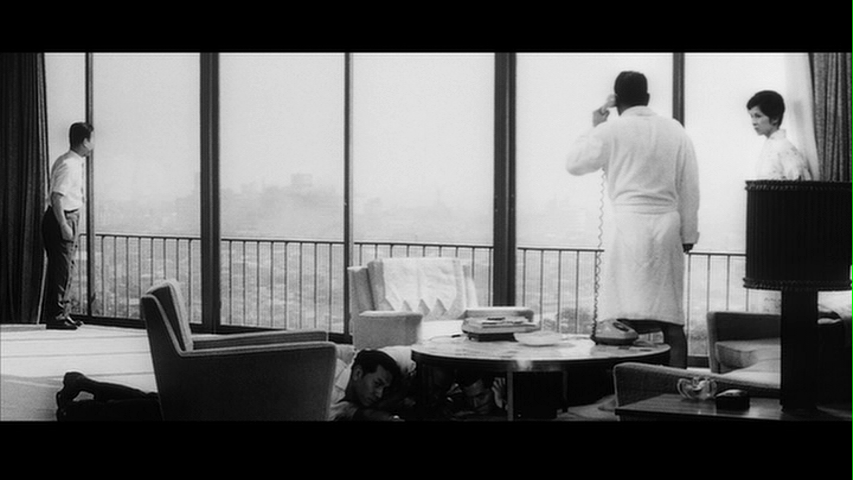
Finally, Gondo resolves that he will pay the ransom against his own self interests. And while it’s a hard sacrifice, Gondo bears up to it surprisingly well. When further demands are made to put the money in thin briefcases, Gondo helps the police by breaking out his tools and helping the police plant devices that may reveal the location of the briefcases if they’re thrown in the water or burned. As usual for Kurosawa, worthwhile work is a great cure for what ails a person and it demonstrates that Gondo is not without the inherent means and will to start over. It’s something everybody in the room finds admirable. He’s done the right thing and instead of complaining about it, he’s at peace. Kurosawa takes the saying “the king sits and the subjects stand” and makes it literal.
It helps that Mifune has delivered a master class in acting. This is a man used to being in control of a situation who is thrust into a position of apparent weakness. But, while we watch him in his crucible we see his basic strengths emerge again.

Change is coming for Gondo and Reiko, who is now wearing a western style dress, but he seems prepared to deal with it.
So ends the first half and “high” portion of the film. Kurosawa splits the film in two with the first half being a chamber drama about Gondo while the second half is a police procedural. And the link is the delivery of the ransom during a high speed train ride. This is the closest Kurosawa comes to an action scene and Kurosawa plays it for maximum tension and excitement.
The main questions of the sequence are how is the exchange going to be pulled off and what is the significance of the demand that the briefcases be of a certain thickness? Turns out that there’s a phone on the train and the kidnapper calls and arranges for Gondo to see the kidnapped boy on one side of a specific bridge and orders Gondo to dump the briefcases out a bathroom window, a window which only opens a limited amount, on the other side of the bridge. The plan is ingenious as there’s no way to stop the train and pursue the kidnappers without giving them plenty of warning and endangering the boy. The only thing they can do is record the transfer with movie cameras and high quality cameras.
Kurosawa shoots the hell out of the sequence. He uses deep focus to show Gondo and the police officers monitoring him in one shot. There’s handheld camera work as they race through the train. The sound of the train is omnipresent, communicating the speed of the train and the fact that there’s not much that they can do that can stop course of action. And, like the recording of the phone calls, the recording of the exchange via movie cameras is all that the police can manage.
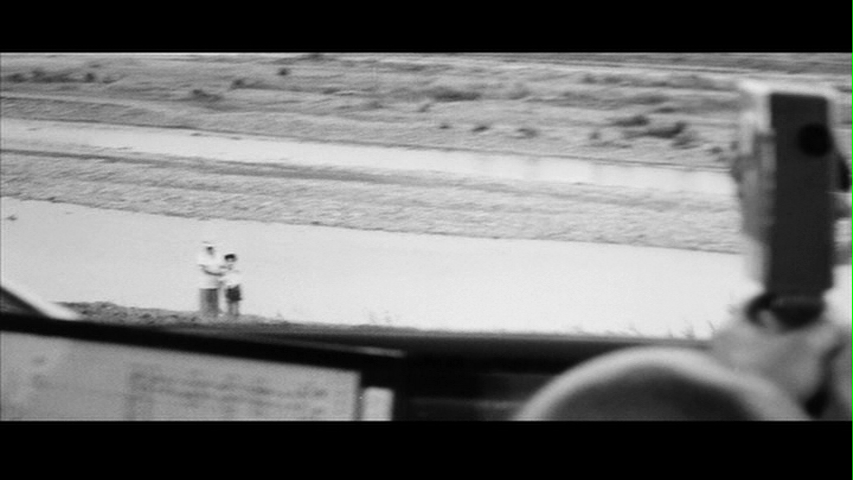
The boy is delivered safely, which was the main goal and the police investigation rapidly expands. The police move in and quickly scout out which pay phones have a view of Gondo’s living room. Visually we’re clearly in the “low” portion of the story as Kurosawa pans down from Gondo’s opulent house to a poor, litter strewn neighborhood where we get our first glimpse of the kidnapper as he anonymously walks past the detectives investigating phone booths and we follow him back to his slum apartment. We watch him as he reads the newspapers to gather information and learns that his plan to bring Gondo down seems to be backfiring, as Gondo is getting national acclaim for his sacrifice.
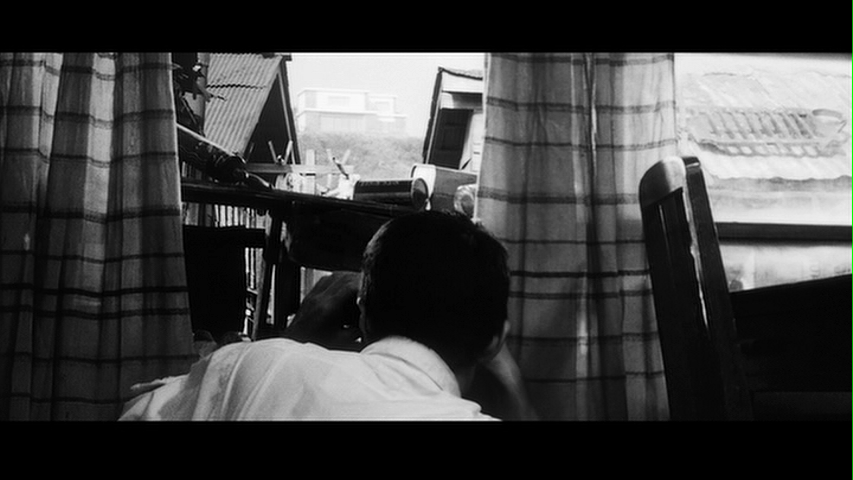
Kurosawa transitions easily from the kidnapper watching the house to assess his damage to the police investigation in the house which is drawing blanks on linking the images captured by the police to suspects. The chauffer’s yelling at his son doesn’t help, but demonstrates the desperation of the situation. And the banks are already moving in on Gondo which further motivates the police detectives.
Not that motivation alone is going to solve the crime. Kurosawa then brings forth an epic police briefing scene summarizing all the clues and problems to locate one man in a major city. One of Kurosawa’s great strengths is to get across information quickly and efficiently, and a police procedural, which relies heavily on piecing together information, is something Kurosawa was born to direct. From maps to the results of interviews to forensic evidence, Kurosawa brings a ton of seemingly disconnected information together which underlines both the enormity of the task before the police and the tools they can bring to bear which makes it a task that’s daunting, not impossible.
Kurosawa makes sure it’s not just an information dump though. Takashi Shimura and Susumu Fujita get small cameos as senior officials lending an air of gravity to the scene. And Bos’n is a reliable source of humor. Bos’n was in charge of interviewing the National Shoes’ executives and plant workers, and while he has no real results, he non-verbally communicates what he thinks of the executives.

Tatsuya Nakadai’s Inspector Tokura is all professional, but it’s underlined by a real desire to save Gondo. He’s the clear leader and it’s a nice showcase of Nakadai’s range after previously playing a pair of villains. The immediate course of action is for Bos’n to pick up the chauffer’s son, drive along the coast where he was being held, and see if the son can remember and help track down where he was being held. But, Kurosawa isn’t just going to wait around, the police work through the night finding a stolen car, splashed with mud even though it hasn’t rained. The audio experts also identify a trolley in the background which helps them narrow down the possible locations of the kidnappers’ hideout.
Complicating matters is that when Bos’n goes to pick up the chauffer’s son, he finds that the chauffer has set out with his son to find the kidnapper’s hideout himself. Without any choice, Bos’n and his partner set out to find the hideout armed with nothing more than a child’s picture of Mount Fuji, the sea, and a sunset, mud splatter on the kidnapper’s stolen car when there’s no rain, and the general vicinity of a trolley line as their only clues.
What follows is a sequence of cross-cutting as the two investigations close in on each other and threatening to intersect at any moment. There’s a bit of playfulness into this section, which elicits a sense of joy as the two investigations arrive at the same destination, which happens to provide independent confirmation in the process. That sense of joy as the puzzle pieces fall into place and the sense that it’s all too easy are immediately dashed when they find the bodies of the two accomplices of the head kidnapper. It’s another dead end, although they do recover a bit of money. Not enough to rescue Gondo from his perilous financial situation though.
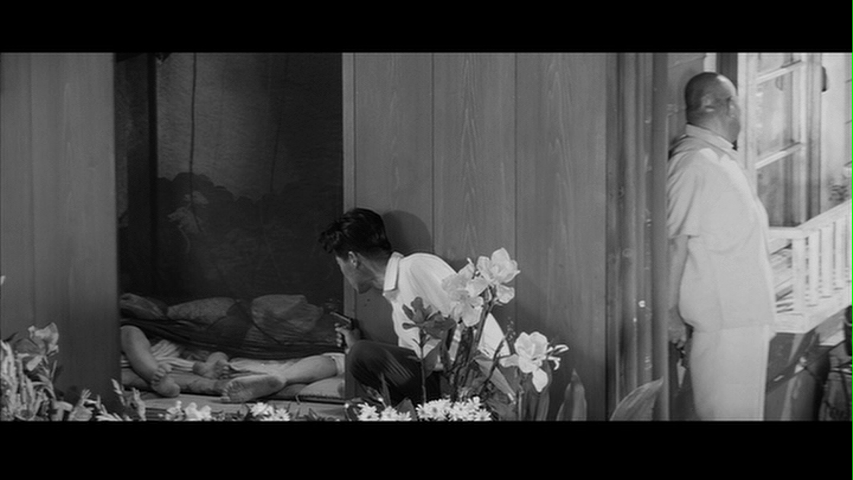
The police suspect that the two accomplices are dead due to an overdose of too pure heroin arranged by the head kidnapper, but have no proof of that or anything that connects those two to the man who apparently covered all of his tracks. With no leads the police turn to the press to play psychological games with the kidnappers. For one thing, Tokura gets the press to not report the deaths, and to report that money has been spent and recovered, in the hopes that the kidnapper will turn up at the staked out hideout or at least to keep him on edge. In addition, the press takes up the cause of Gondo, praising him at the expense of National Shoes, with the hopes that the personal grudge that the kidnapper holds against Gondo will be enraged and elicit mistakes. This is a marked contrast to Scandal in that Kurosawa acknowledges the press can accomplish something good. The press also publishes photos of the pair of cases hoping either to elicit a witness or to get the kidnapper to dispose of them.
It’s at this point that Gondo is given one last temptation. National Shoes in the form of Kawanishi approaches Gondo to come back due to public backlash. The company will bail him out in return for him helping the corporation save face with the public. In one final gesture demonstrating that Gondo has found himself through his honor and sacrifice he refuses this two-faced offer. Immediately after the refusal, there’s a sign of salvation. In one of Kurosawa’s most audacious images, frames of the film were hand painted pink to show the outcome of the briefcases being burned. It’s Kurosawa’s first use of color in film and it’s a memorable one and signals his future bold choices. It’s also the turning point in the investigation and is given a distinctive image to match its importance. Many directors would run aground on an image as blatant as a sign in the heavens, but the movie is very grounded and Kurosawa’s compositions are so sure that it doesn’t clash with the rest of the film.

At once the police spring into action. After an interview with the incinerator operator, in a scene emulated in every episode of Law and Order where the person being interviewed is too busy loading crates and boxes that he can’t pause, the police are pointed in the direction of a local hospital. Bolstered by certain details provided by the chauffer’s son, they soon have a suspect identified. All that seems to be necessary is a search warrant to find the money and proof.

But the police hold off. Tokura doesn’t just want to catch the kidnapper for a measly 5 year sentence, reflecting how lax Japan’s kidnapping laws of the time were, Tokura wants to prove that the kidnapper is a murderer and bring him up for the death penalty. So a trap is laid, a forged note will be delivered demanding more money in the hopes of drawing the kidnapper out in a repeat of his earlier, successful, murder plot.
And it works, but not before Kurosawa gives us one of his most impressive visual sequences as we and the police follow the kidnapper through the lower depths of the city, watch him obtain his heroin, and observe as he picks up a junkie girl to test the potency of the heroin on. It’s a little reductive to say that Kurosawa is presenting a vision of Hell with the Devil in mirrored sunglasses, the film is firmly rooted in a realistic aesthetic which makes it a potent document of then contemporary Japan, but it’s certainly a valid reading.


The cat and mouse game ultimately comes to an end. But not in time to save Gondo’s home. Everything is being put up for sale and Gondo’s wife is fully wearing western outfits. There’s no going back to their old ways. Gondo has been humbled, but we see that despite the hardship he’s honorable and resilient.
All that’s left is a coda. As a last request before his execution, the kidnapper asks to speak with Gondo and Gondo complies. Time has passed and although Gondo is no longer rich, he’s started over with another shoe company and is making shoes he’s proud of, much to the chagrin of the kidnapper. Gondo gives the kidnapper a chance to explain himself, perhaps to grant his forgiveness, but the kidnapper utterly refuses. It’s clear that he’s breaking down under the weight of his subsequent execution, but he’s too proud to ask for forgiveness from someone who represents everything he’s been jealous of. Ultimately, the kidnapper has to be dragged out to his fate and the metal shutter separating the two men slams down. Kurosawa finds a unique and terrific way to frame the conversation by focusing on each individual character, but with the reflection of the other shown in the glass separating them. Kurosawa has demonstrated his mastery of composition throughout, but he perhaps saves his best for last.


In the end, Gondo is left staring at the darkened shutter separating him from his tormenter. It serves as a final curtain coming down on a morality play bookending the lights being turned on at the opening. Gondo and the audience get no real answers as to why he’s been brought down. Kurosawa doesn’t attempt to answer the question of why bad things happen to people. Despite that, I don’t believe the film ends on a downer message. Gondo may now be living in reduced circumstances, but he has hopes to rebuild and suffers from no lack of work ethic. Gondo’s inner strengths are intact, despite the setback, and that’s a path forward.
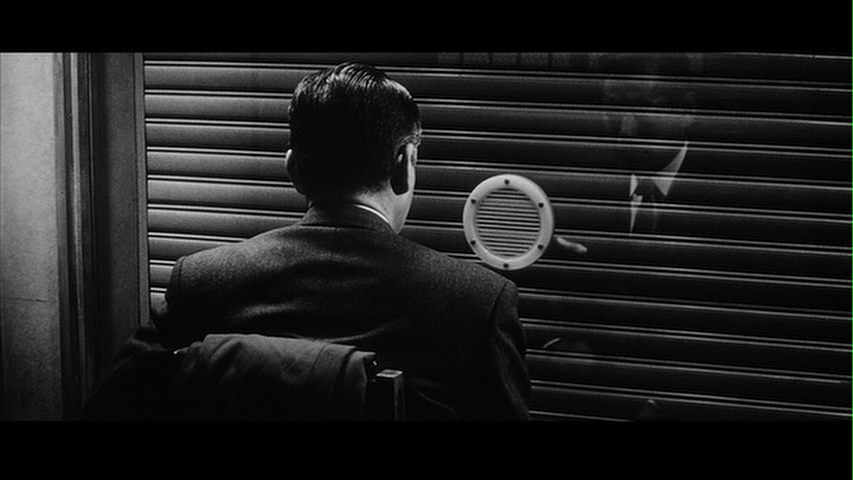
The film is a masterpiece and it garnered awards and was very popular. Perhaps even more satisfying to Kurosawa, Japan increased the penalties for kidnapping almost immediately following the release of the film. Kurosawa wanted to be a director that had an effect on society and he undoubtedly did with High and Low.
Kurosawa was undoubtedly at the top of his game and so was Toshiro Mifune. But perhaps unknown to both of them, the end of an era was fast approaching. Kurosawa again turned to a period piece and he again turned to Mifune as his leading man, but the long, difficult shoot would be their last.
Next Time: RED BEARD (1965)